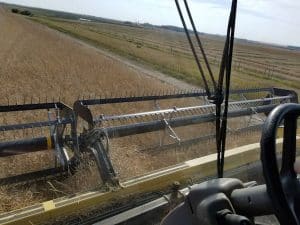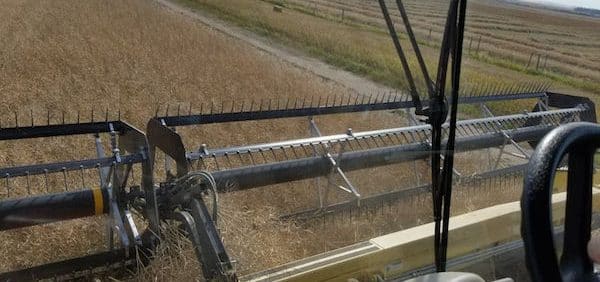Leaving canola to ripen naturally can work well for straight combining and it saves the extra pass and cost of pre-harvest applications. But canola left to ripen naturally will have somewhat tougher and greener plant material than a swathed crop would, even when seeds are cured and ready to combine.
Should you wait for further dry down or get started and take it slow?
Waiting could help, especially if the hybrid has pod-shatter tolerance. Work conducted by Indian Head Agricultural Research Foundation found limited losses in shatter tolerant canola, even when waiting approximately 3-4 weeks after the seed had reached 10% moisture content.

If you want to get started, consider these tips:
Cut higher than you would with the swather. This reduces the amount of material going through the combine and will increase capacity.
Slow the ground speed. Some rotor designs handle green material better than others, but in general, slower ground speed could put less strain on the rotor and will limit the chances of plugging. Watch for loss of RPM’s on the rotor and pull back on ground speed to allow the material to pass before trying to push more through.
Adjust settings, part one. When straight combining canola with greener stalk material, losses are less likely to occur because of overloading the shoe (as is commonly the case in very dry swathed crop where travel speed can exceed cleaning capacity of the machine). What can happen more often in green material are rotor losses. If this is an issue, try the two extremes of wide concave clearance and slow rotor speed OR tight concave clearance and fast rotor speed.
Adjust settings, part two. To improve threshing of greener rubbery pods, it may help to (1) increase rotor speed, (2) tighten concave clearance and (3) adjust mid vanes to hold material longer. As pods dry down, make adjustments as needed – as a combination of all of these things can drastically increase threshing for a crop that is typically somewhat easy to thresh. Check the degree of cracked seeds in the tank as the day goes on, and consider decreasing the degree of threshing later in the day. You may find that (4) sieve and (5) fan settings will also be different for green standing versus swathed dry canola. You may find you need to return more in a standing crop than you would ever consider in a swathed crop. This will improve cleaning and keep green dockage out of the grain tank. Green dockage can increase storage risk, even if the grain itself is dry.
If running with concaves wider is appropriate for the conditions, never run with them totally open. That’s because if the threshing area plugs, you no longer have the ability to drop down the concaves for easier clearing of the plugged material.
Watch and listen. Listen to the combine and watch the gauges. Slow the ground speed as the sound of heavy threshing increases or rotor speed drops.
Have the machine in good working order. The negative effects of worn rotor intake flighting and chopper knives become quickly apparent in green material. Keep things sharp for straight combining canola.
Further reading:
PAMI study on straight cutting and pre-harvest applications
More Canola Watch articles on straight combining
